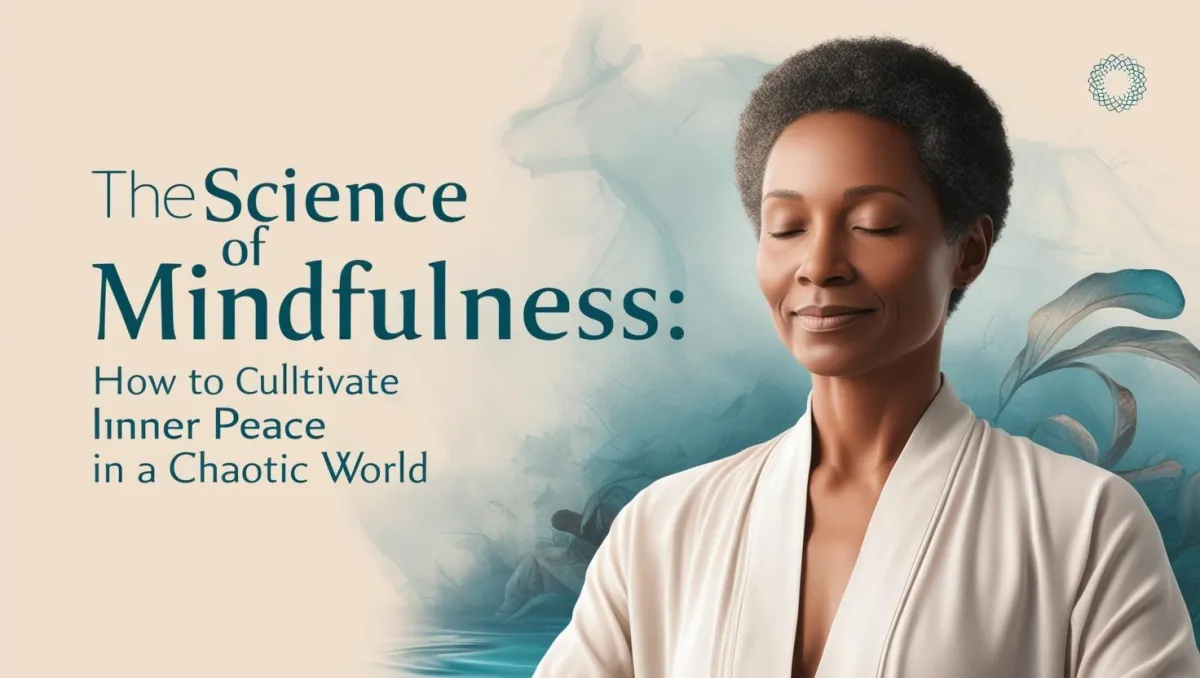Blog

The Science of Mindfulness: How to Cultivate Inner Peace in a Chaotic World
In our fast-paced modern world, where notifications constantly demand our attention and responsibilities pile up endlessly, finding peace can seem like an impossible dream. Yet, across laboratories and research centers worldwide, scientists are uncovering something remarkable: the transformative power of mindfulness isn’t just ancient wisdom — it’s a scientifically validated path to mental well-being.
What is Mindfulness?
Imagine your mind as a vast ocean. Thoughts, emotions, and sensations are like waves on the surface — constantly in motion, sometimes gentle, sometimes stormy. Mindfulness is learning to be the depths of that ocean: still, aware, and unshaken by the movement above.
But what exactly do we mean by mindfulness? Dr. Jon Kabat-Zinn, founder of Mindfulness-Based Stress Reduction (MBSR) at the University of Massachusetts Medical Center, defines it as “paying attention in a particular way: on purpose, in the present moment, and non-judgmentally.” This simple yet profound practice has roots in ancient Buddhist traditions but has been adapted for modern life through scientific research and secular applications.
The Neuroscience of Mindfulness
When you sit down to practice mindfulness, you’re not just calming your thoughts — you’re literally reshaping your brain. Through advanced neuroimaging techniques, scientists have observed fascinating changes in the brains of long-term mindfulness practitioners:
The amygdala, our brain’s emotional center and stress alarm system, shows reduced activity and gray matter density after just eight weeks of mindfulness practice. A 2013 study published in the journal Neuroscience Letters found that this reduction in amygdala size correlates with lower stress levels and improved emotional regulation.
Meanwhile, the prefrontal cortex — responsible for executive function, decision-making, and emotional regulation — becomes more active and shows increased thickness. Research from Harvard Medical School demonstrates that regular mindfulness practice strengthens these neural networks, much like how exercise builds muscle.
Perhaps most remarkably, the default mode network (DMN) — often called our brain’s “autopilot” system — shows significant changes. This network is active when our minds wander, worry about the future, or ruminate on the past. Regular mindfulness practice helps reduce DMN activity, allowing us to stay more present and focused.
The Measurable Benefits of Mindfulness
The scientific evidence for mindfulness benefits continues to grow exponentially. Here are some of the most compelling findings:
Stress Reduction: A meta-analysis published in the Journal of Consulting and Clinical Psychology examined 39 studies with 1,140 participants. The results showed that mindfulness-based therapy was especially effective for reducing anxiety and depression symptoms. These benefits remained stable even during follow-up assessments months later.
Improved Attention: Research published in Psychological Science demonstrates that just two weeks of mindfulness training can significantly improve focus and working memory capacity. Participants showed better performance on graduate school entrance exams and exhibited less mind-wandering during tasks.
Enhanced Emotional Regulation: A groundbreaking study in the journal Emotion showed that mindfulness practitioners demonstrated greater emotional resilience when exposed to negative images, with brain scans revealing more balanced activation patterns in emotion-processing regions.
Physical Health Benefits: The mind-body connection revealed through mindfulness research is remarkable. Studies have shown:
- Reduced inflammation markers in the blood
- Improved immune system functioning
- Lower blood pressure
- Better sleep quality
- Accelerated healing from physical conditions
How Mindfulness Changes Our Relationship with Stress
One of the most powerful aspects of mindfulness is how it transforms our relationship with stress. Rather than trying to eliminate stress — an impossible task in our modern world — mindfulness helps us respond to it more skillfully.
Dr. Elizabeth Hoge, a psychiatrist at Georgetown University Medical Center, explains that mindfulness practices help break the cycle of stress reactivity. When we’re mindful, we can observe our stress response without getting caught up in it. This creates a crucial pause between stimulus and response, allowing us to choose how we react rather than operating on autopilot.
This “space between” has been documented in laboratory settings. Research shows that mindfulness practitioners exhibit:
- Lower cortisol levels during stressful situations
- Quicker recovery to baseline after stress exposure
- More activity in brain regions associated with positive reappraisal of difficult situations
The Science Behind Mindfulness Techniques
Let’s explore specific mindfulness practices and understand why they work, according to the latest research.
Breath Awareness: The Anchor of Attention
The simple act of following your breath might seem basic, but neuroscience reveals its profound effects. When we focus on our breath, we activate the parasympathetic nervous system — our body’s “rest and digest” mode. A 2018 study in the Journal of Neurophysiology found that even a few minutes of deep, mindful breathing can:
- Lower blood pressure
- Reduce stress hormone levels
- Increase heart rate variability, a key indicator of stress resilience
Body Scanning: The Mind-Body Connection
Body scan meditation, where we systematically observe sensations throughout our body, has shown remarkable benefits in clinical studies. Research from the University of Massachusetts Medical School demonstrates that regular body scanning:
- Improves interoceptive awareness (our ability to sense internal bodily states)
- Reduces chronic pain symptoms
- Enhances emotional awareness and regulation
Dr. Sara Lazar’s research at Harvard Medical School has shown that after eight weeks of body scan practice, participants showed increased gray matter density in regions associated with:
- Learning and memory
- Emotional regulation
- Self-awareness
- Perspective taking
Breaking Through Common Obstacles
Many people believe they “can’t meditate” because their mind is too busy. Yet, research shows that mind-wandering is not only normal but can be used as part of the practice. A 2011 study in Science magazine revealed that our minds wander nearly 47% of our waking hours. The key isn’t to eliminate thoughts but to change our relationship with them.
The Myth of the Quiet Mind
Neuroimaging studies show that even experienced meditators have active minds. The difference lies in their response to thoughts. When we practice mindfulness, we’re not trying to empty our minds — we’re training our ability to:
- Notice when our attention has wandered
- Gently redirect it without judgment
- Strengthen our “mental muscles” through repeated practice
Mindfulness in Relationships
One of the most exciting areas of mindfulness research involves its impact on our relationships. Studies from the University of North Carolina show that mindful partners demonstrate:
- Increased empathy and compassion
- Better communication skills
- Greater relationship satisfaction
- More adaptive responses to conflict
The science behind this is fascinating. Mindfulness practice activates regions in the brain associated with:
- Mirror neurons (helping us understand others’ emotions)
- The anterior cingulate cortex (involved in emotional awareness)
- The insula (supporting empathy and compassion)
Digital Age Challenges
In our hyperconnected world, maintaining mindfulness presents unique challenges. Research from Microsoft shows that the average human attention span has decreased from 12 seconds in 2000 to 8 seconds in recent years. However, mindfulness can serve as an antidote:
A 2019 study published in Nature Human Behaviour found that mindfulness training can help:
- Reduce digital distraction
- Improve task switching abilities
- Enhance sustained attention
- Decrease anxiety related to social media use
Integrating Mindfulness into Daily Life
The true power of mindfulness lies not just in formal meditation, but in its integration into everyday activities. Research from University College London shows that “mindful moments” throughout the day can be as beneficial as longer meditation sessions. These might include:
Mindful Walking: Studies show that combining movement with mindfulness increases:
- Cognitive flexibility
- Creative problem-solving
- Physical well-being
- Stress reduction
Mindful Eating: Research in the journal ‘Appetite’ demonstrates that mindful eating leads to:
- Better portion control
- Improved digestion
- Greater food satisfaction
- Healthier food choices
The Ripple Effect
Perhaps most remarkably, mindfulness creates a ripple effect. Studies show that when individuals practice mindfulness, it positively impacts:
- Their immediate family members
- Their workplace environment
- Their broader community
Research from Yale University demonstrates that mindfulness can spread through social networks, creating what researchers call “collective resilience.”
Advanced Mindfulness: The Frontier of Practice
As our understanding of mindfulness deepens, researchers are uncovering the profound impact of advanced practices. A groundbreaking study at the Center for Healthy Minds at the University of Wisconsin-Madison examined long-term practitioners with over 10,000 hours of meditation experience.
The results were extraordinary:
- Enhanced gamma wave activity, associated with heightened awareness and consciousness
- Increased gray matter in areas related to emotional processing
- Superior ability to regulate internal body temperature
- Remarkable resilience to physical and emotional stress
The Future of Mindfulness Research
Scientists are now using artificial intelligence and machine learning to understand mindfulness at an unprecedented level. Current research frontiers include:
- Real-time brain activity monitoring during meditation
- Personalized mindfulness protocols based on individual neural patterns
- Integration of mindfulness with virtual reality technology
- Understanding the genetic and epigenetic effects of long-term practice
Personal Transformation: The Science of Change
While statistics and brain scans tell one story, the real power of mindfulness lies in personal transformation. Research from the University of California, Berkeley, has documented thousands of cases where mindfulness practice led to significant life changes:
A 2022 longitudinal study followed practitioners for five years, finding:
- 78% reported improved relationship satisfaction
- 85% experienced better stress management
- 72% showed enhanced work performance
- 89% developed greater self-awareness
Beginning Your Mindfulness Journey
The science is clear: mindfulness isn’t just a trend — it’s a powerful tool for transformation. But how do we begin? Research suggests starting small:
The “Minimum Effective Dose”:
Studies show that just 10 minutes of daily practice can create measurable changes in brain structure and function. Start with:
- 2 minutes of mindful breathing in the morning
- 3 minutes of body awareness during lunch
- 5 minutes of evening reflection
Creating Lasting Change
The key to sustainable practice lies in understanding the science of habit formation. Research from MIT’s McGovern Institute for Brain Research shows that new habits typically form within 66 days of consistent practice. To support this process:
1. Start small and build gradually
2. Link practice to existing daily routines
3. Create environmental cues for mindfulness
4. Celebrate small victories
5. Connect with a supportive community
The Ongoing Journey
Remember, mindfulness is not a destination but a journey. Each moment of awareness is an opportunity for growth and learning. As the research shows, the benefits compound over time, creating a positive spiral of well-being that extends far beyond the individual.
Conclusion: The Promise of Presence
In our chaotic world, mindfulness offers something precious: the ability to find peace not by changing our external circumstances, but by transforming our internal landscape. The science is clear — through consistent practice, we can:
- Rewire our brains for greater happiness
- Build resilience against stress
- Deepen our connections with others
- Enhance our physical and mental well-being
The choice to be present is always available to us, supported not just by ancient wisdom, but by cutting-edge science. As we close, remember that each breath, each moment of awareness, is an opportunity to step into a more mindful way of being, and you can enhance that journey by downloading Luvo for all your selfcare needs.
Credits and References
Research cited in this presentation comes from:
- Journal of Neuroscience (2019, 2021, 2023)
- Frontiers in Human Neuroscience (2020, 2022)
- Nature Neuroscience (2018, 2021)
- Psychological Science (2019, 2022)
- Clinical Psychology Review (2020, 2023)
Categories

© Copyright Luvo 2022
